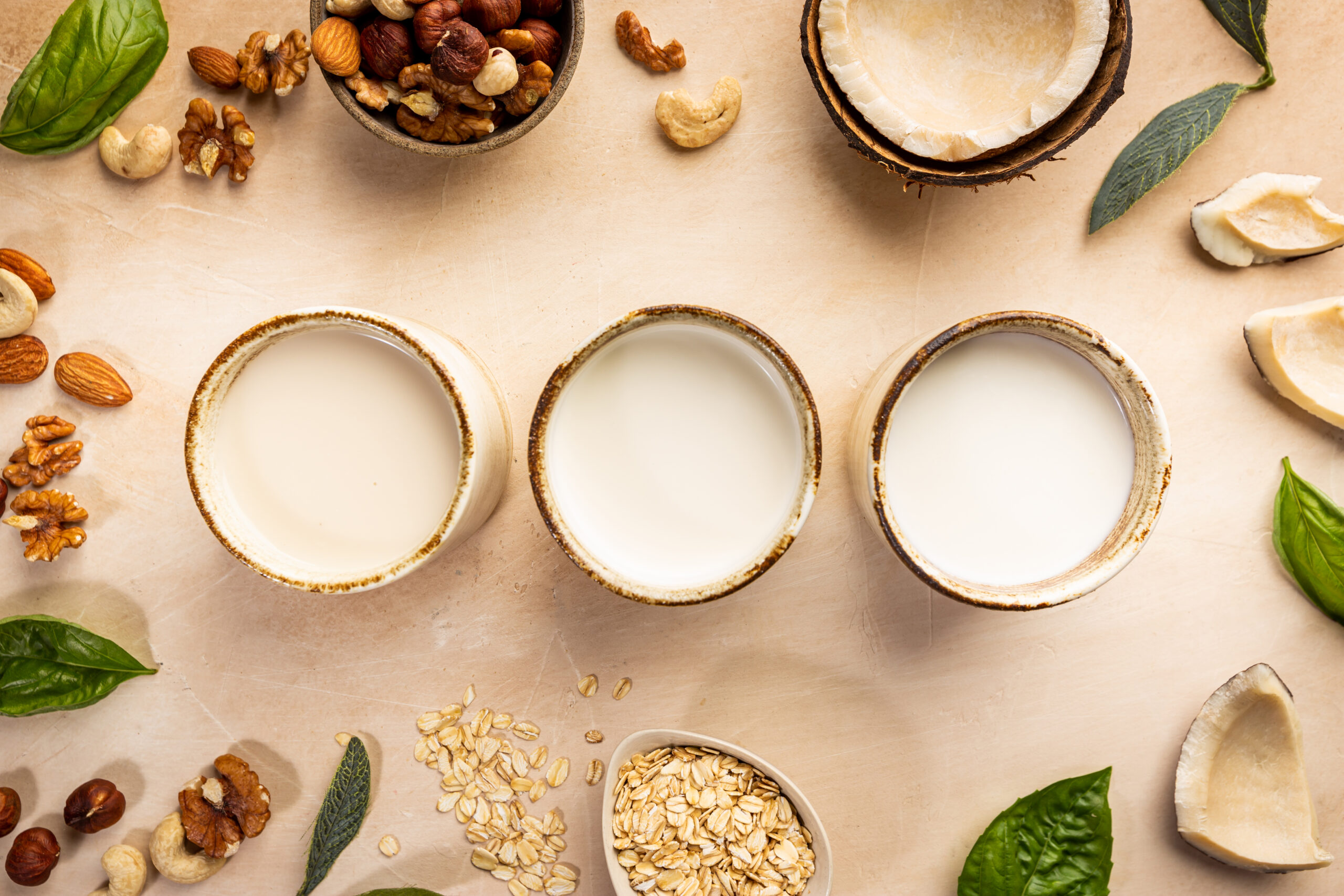Lactose is, in other words, milk sugar. It is an organic chemical compound. This chemical structure means lactose belongs to carbohydrates and is a disaccharide consisting of D-galactose and D-glucose.
Lactose is a compound that gives milk a sweet taste, although it is also less sweet than glucose or sucrose. Sugar is the standard source of carbohydrates in infant nutrition and is responsible for 40% of calories that come from milk. It is a highly soluble compound that supports calcium absorption, and its fermentation produces butyric acid, which affects healthy intestinal microflora and nourishes intestinal cells.

Lactose![]() , a colorless substance with a constant melting point of 225 degrees Celsius, dissolves well in water, poorly in alcohol, and not in ether. In cow's milk, its concentration ranges from 4.6 to 4.9%, and in human milk, it's from 5.5 to 7.5%.
, a colorless substance with a constant melting point of 225 degrees Celsius, dissolves well in water, poorly in alcohol, and not in ether. In cow's milk, its concentration ranges from 4.6 to 4.9%, and in human milk, it's from 5.5 to 7.5%.
Lactose is glucose and galactose, and the enzyme lactase digests them. It is produced in the brush border of the small intestine's mucous membrane. The intestine absorbs glucose and galactose under the influence of lactase, which can then be used as an energy source for the body's functioning.
The highest lactase activity is in newborns and infants. As people age, lactase activity decreases; in most adults, it reaches about 10% of the original activity.
Lactose intolerance![]() is when the body cannot fully break down and absorb lactose. It happens when the body doesn't produce enough lactase. When there's insufficient lactase, all the lactose travels to the large intestine. In the large intestine, the lactose becomes a perfect food for bacteria. As a result, the bacteria produce hydrogen, carbon dioxide, and short-chain organic acids.
is when the body cannot fully break down and absorb lactose. It happens when the body doesn't produce enough lactase. When there's insufficient lactase, all the lactose travels to the large intestine. In the large intestine, the lactose becomes a perfect food for bacteria. As a result, the bacteria produce hydrogen, carbon dioxide, and short-chain organic acids.
Furthermore, undigested lactose holds water in the large intestine, leading to a larger stool volume. The acids produced during fermentation make the stool more acidic. For people with intolerance, symptoms like severe abdominal pain, bloating, foul-smelling gas, nausea, and diarrhea can start as soon as 30 minutes after consuming lactose-containing food.
Many factors may cause lactose intolerance. Taking these factors into account, specialists list three basic types of lactose intolerance, which are also the causes of lactose intolerance.
Congenital lactose intolerance![]() in infants, i.e., called alactasia, is a sporadic form of lactose intolerance disorder. Such lactose intolerance is detected already in infancy. Patients diagnosed with primary lactose intolerance are forced to follow the principles of a lactose-free diet.
in infants, i.e., called alactasia, is a sporadic form of lactose intolerance disorder. Such lactose intolerance is detected already in infancy. Patients diagnosed with primary lactose intolerance are forced to follow the principles of a lactose-free diet.
Primary lactose intolerance![]() in adults, i.e., hypolactasia, is a disorder that appears and increases with age. In adults, with age, the activity of lactase, which breaks down lactose into glucose and galactose, decreases. In these people, there were no problems with digesting lactose in childhood. Usually, this type of lactose intolerance is genetically determined (intolerance is inherited as an autosomal recessive trait) and ethnically.
in adults, i.e., hypolactasia, is a disorder that appears and increases with age. In adults, with age, the activity of lactase, which breaks down lactose into glucose and galactose, decreases. In these people, there were no problems with digesting lactose in childhood. Usually, this type of lactose intolerance is genetically determined (intolerance is inherited as an autosomal recessive trait) and ethnically.
Secondary lactose intolerance![]() is a disorder resulting from damage to the intestinal epithelium due to disease processes. This means that lactose intolerance is an acquired disorder. Secondary lactose intolerance can be temporary or permanent. It depends on the type and duration of the factor that damages the small intestine mucous membrane. Temporary cases usually occur after taking drugs that can destroy the intestinal mucosa, primarily antibiotics. Permanent, secondary lactose intolerance, in turn, is a consequence of diseases such as celiac disease, cystic fibrosis, Crohn's disease, carcinoid tumors, gastrointestinal allergy, or giardiasis.
is a disorder resulting from damage to the intestinal epithelium due to disease processes. This means that lactose intolerance is an acquired disorder. Secondary lactose intolerance can be temporary or permanent. It depends on the type and duration of the factor that damages the small intestine mucous membrane. Temporary cases usually occur after taking drugs that can destroy the intestinal mucosa, primarily antibiotics. Permanent, secondary lactose intolerance, in turn, is a consequence of diseases such as celiac disease, cystic fibrosis, Crohn's disease, carcinoid tumors, gastrointestinal allergy, or giardiasis.
The symptoms of lactose intolerance result from the lack of digestion and absorption of lactose in the intestines, which is in the form of glucose and galactose. Undigested lactose accumulates in the intestinal lumen, where fermentation occurs and gases and acids are produced.
The symptoms of lactose intolerance![]() are not specific and very often resemble symptoms characteristic of many other digestive tract diseases. The symptoms of lactose intolerance include primarily:
are not specific and very often resemble symptoms characteristic of many other digestive tract diseases. The symptoms of lactose intolerance include primarily:
The symptoms and their severity depend on the amount of lactose-containing food consumed. The rule is straightforward: the more lactose-rich products we eat, the more severe the symptoms will be. Symptoms of lactose intolerance can manifest as soon as 30 minutes after consuming lactose-containing food, while in some cases, they may only appear a few hours later. In such instances, individuals often fail to connect the symptoms with the food they've consumed and may not even suspect that they could be indicative of lactose intolerance.

If symptoms characteristic of lactose intolerance occur, you should consult a doctor. It would help if you never diagnosed lactose intolerance on your own. It is worth going to a general practitioner first, who (after a thorough interview and initial examination) will issue a referral to a specialist.
In the case of lactose intolerance, it is worth listening to the advice of a dietician because the treatment is mainly based on an elimination diet. An elimination diet involves removing products that contain lactose from the diet.
Conduct the appropriate diagnostic tests![]() if lactose intolerance is suspected. The tests that a doctor may order include:
if lactose intolerance is suspected. The tests that a doctor may order include:
It's important to remember that lactose intolerance cannot be cured, and the best way to manage its symptoms is by making dietary changes![]() . If you've been diagnosed with lactose intolerance, consider following an elimination diet that focuses on lactose-free products.
. If you've been diagnosed with lactose intolerance, consider following an elimination diet that focuses on lactose-free products.
There are no medications for lactose intolerance. The basis of treatment is to reduce the lactose content in the diet to an amount that does not cause intolerance symptoms. It is also emphasized that, except for congenital lactase deficiency, complete exclusion of lactose from the diet is not necessary and is even not recommended. Lactose has a prebiotic effect on lactic acid bacteria and increases the adaptation of intestinal microbiota to its metabolism. It indirectly affects the mechanism of its tolerance.
Preparations containing lactase, an enzyme that allows the breakdown of ingested lactose and prevents its accumulation in the small intestine, are available in pharmacies. Preparations for lactose intolerance are available in tablets or drops for infants. Due to the immediate effect of the enzyme after its oral administration, it should be administered immediately before each meal containing milk or dairy products. Preparations are recommended for all people who experience bloating, abdominal pain, gas accumulation, or diarrhea immediately after consuming dairy products.
Many people think that stopping consuming milk and all dairy products is enough to eliminate lactose from their diet. Of course, this is necessary, but it is not a sufficient condition for a proper elimination diet. Lactose is commonly used in food production.
To effectively reduce lactose consumption, you should carefully read the compositions of the products you choose. In addition to typical dairy products, special care should be taken when buying the following products:
The primary sources of lactose![]() are:
are:
In cases of diagnosed lactose intolerance, choose products that do not contain lactose. As the table above indicates, milk contains a lot of lactose, but the amount of sugar in it decreases significantly during milk processing. For example, yogurts, buttermilk, and mature cheeses contain small amounts of lactose and can be included in the diet of people with lactose intolerance to a limited extent.
The good news for people with lactose intolerance is that many products are currently available on the market from which lactose has been isolated. Therefore, you can buy lactose-free![]() milk, cheese, or other products without this disaccharide.
milk, cheese, or other products without this disaccharide.
People with congenital lactase deficiency or severe lactose intolerance should avoid milk sugar products. Cow's, goat's, sheep's, and other mammalian milk can be successfully replaced with plant milk: buckwheat (from buckwheat grains and soy), soy, rice (from brown rice), coconut (made from squeezed coconut pulp), corn (based on corn syrup) or oat and products made from them. Tofu cheese made from soy milk is especially recommended for lactose intolerance because it is a good source of calcium and protein. Unfortunately, it can cause allergies, and with long-term use, it can cause thyroid problems.
In addition, lactose-free milk cheeses and other dairy products that do not contain milk sugar are available in stores. They are labeled “lactose-free.” It is worth knowing that milk that does not contain lactose has the same amount of calcium as regular milk.

Good sources of vitamin B2![]() in the diet of people with lactose intolerance can be soy milk and its products fortified with this vitamin. Some types of this milk contain even more vitamin B2 than cow's milk. Other good sources of this vitamin include meat, buckwheat, millet, oatmeal, legumes and green peas, Savoy cabbage, Brussels sprouts, and spinach.
in the diet of people with lactose intolerance can be soy milk and its products fortified with this vitamin. Some types of this milk contain even more vitamin B2 than cow's milk. Other good sources of this vitamin include meat, buckwheat, millet, oatmeal, legumes and green peas, Savoy cabbage, Brussels sprouts, and spinach.
Soy milk and its products if they are fortified with vitamin B12 may be good sources of vitamin B12 in the diet of people with lactose intolerance. Fortified soy milk contains a similar amount of vitamin B12 to cow's milk. Rich sources of this vitamin are meat, liver, fish, and eggs.
The diet![]() should start with the elimination of milk and dairy products and then gradually reintroduce them to establish the maximum amount of lactose that does not cause intolerance. Daily, regular consumption of products providing lactose is better tolerated than its occasional consumption.
should start with the elimination of milk and dairy products and then gradually reintroduce them to establish the maximum amount of lactose that does not cause intolerance. Daily, regular consumption of products providing lactose is better tolerated than its occasional consumption.
Food products with a high lactose content are better tolerated when they contain fats, slowing gastric emptying and intestinal transit (e.g., ice cream, full-fat milk). Consume lactose products in several smaller portions during the day rather than in one meal. Consuming dairy in the form of fermented products improves lactose tolerance.
Limiting the lactose content to 5-10 g in a single portion of a dairy product is usually well tolerated.
Available methods for reducing lactose in the diet:
If you have poor milk tolerance, replace it with fermented products such as yogurt, kefir, sour milk, and buttermilk.
People who significantly limit their dairy intake should ensure that they include other sources of calcium![]() , protein, and vitamin D
, protein, and vitamin D![]() in their diet. Such products include calcium-enriched soy, almond, nut, oat, rice drinks, tofu, or soy cheese.
in their diet. Such products include calcium-enriched soy, almond, nut, oat, rice drinks, tofu, or soy cheese.